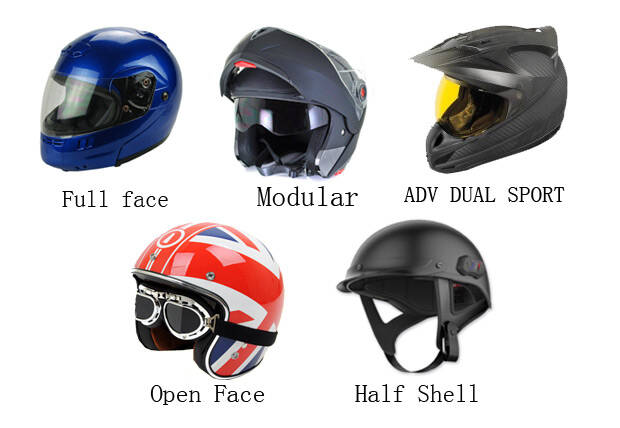Home Scooter News How to choose Motorcycle Helmet ? A Buying Guide to Motorcycle Helmets
How to choose Motorcycle Helmet ? A Buying Guide to Motorcycle Helmets
Dec 13,2009
A scooter and motorcycle helmet is designed to protect your head in the event of a crash, and different types offer different levels of protection. Below is a list of the main types of helmet on the market, along with their relevant safety features.
Body protection is a must when riding your motorcycle and nothing could be more important than a helmet. You likely did some research before deciding on a motorcycle so you're going to want to do the same before grabbing any 'ole helmet.
You'll notice a motorcycle helmet looks much different from a dirt bike or motocross helmet. Helmets designed for motorcycles are more round without the extended chin protection needed for dirt bike riding. Plus, you have a variety of choices depending on your preference:

Full Face Helmets
Full Face Helmet is what most people will have in mind when they think of a motorcycle helmet. A full face helmets is designed to protect your whole face. Its chin guard and visor give extra protection that other scooter helmets lack. However, the main drawback with full-face helmets is ventilation. Look for helmets that have vents on the side, and moisture wicking fabric inside. If you're looking for the maximum protection from a helmet, Full Face Helmet is your best choice.
Open Face Helmets
Possibly the most common style for scooter riders. Open face helmets have the same structural design as a full face, but don't have a chin guard. Some open face helmets have a visor, whereas others are completely open. They obviously offer less coverage than a full-face helmet, but many people prefer them for the airy feel. If you decide to buy a completely open face helmet, make sure you invest in some high quality goggles, and possibly a scarf.
Modular Helmets
Modular Helmets are essentially a hybrid between open- and full-face helmets. They make a good choice as a scooter helmet, because they're versatile and suit both city riding and cruising. They are the same shape as a full face, but the chin guard either flips up, or comes off entirely. While they are similar in design to a full face, they don't offer as much protection. Although the hinge adds weakness to a solid structure, Modular Helmets are still safer than open face helmets.
Motocross Helmets
Motocross helmets are easily recognisable, and look very similar to normal full-face helmets. They usually have a sun visor, and a more angular chin guard. They are designed to be more lightweight than regular helmets, and are favoured by many for their improved ventilation. However, this means you lose some padding, but shouldn't compromise on safety because of the materials used.
Half Helmets
These offer the least protection, and are the sort of thing you expect chopper riders to wear. They might seem like a suitable choice as a scooter helmet because they're lightweight and portable, but you sacrifice safety as a result. They still protect your head however, usually from the forehead to level with your ears. If you decide to buy a half helmet, make sure you get some eye protection.
They type of helmet you choose will depend mostly on your style of riding and the level of safety you need. For new riders, and those with more powerful vehicles, full face would be best. But if you're more experienced, you could start looking at an open fac.
What Features Do You Want?
Helmet Shell Material
What the helmet is made of influences a number of factors including weight, comfort and safety rating. Polycarbonate, Fiberglass composite and Carbon Fiber compose most helmets with a layer of expanded polystyrene (EPS) foam.
Polycarbonate - flexes as it absorbs energy (less expensive material)
Fiberglass composite - flexes, crushes and splits as it absorbs energy (more expensive)
Carbon fiber - distributes energy upon impact (most expensive and lightest)
EPS - foam material densely compressed into a shock absorbing inner shell
Helmet Weight
Helmets typically range in weight from 1400 to 1800 grams. The key to weight is a properly fitting helmet so the weight is distributed evenly around your head and shoulders. If the center of gravity is off a lighter helmet can feel heavier and strain your neck. Modular helmets often weigh more than a Full Face because of the apparatus installed to flip up the visor.
Comfort features
Today's helmets offer numerous technological advances. Features like integrated sunshade, wind reduction measures and communication provisions all serve to enhance the riding experience.
Additional Safety Features
Technology has moved motorcycle helmets into the 21st century with innovative safety features like the emergency cheek pad system or similar system that allows access to an injured rider's head by making helmet removal safer and easier for medical personnel.
New to the scene but gaining fast traction with manufacturers is the Multi-directional Impact Protection System (MIPS), which is an innovative slip-plane technology inside the helmet designed to reduce rotational forces that can result from certain impacts.